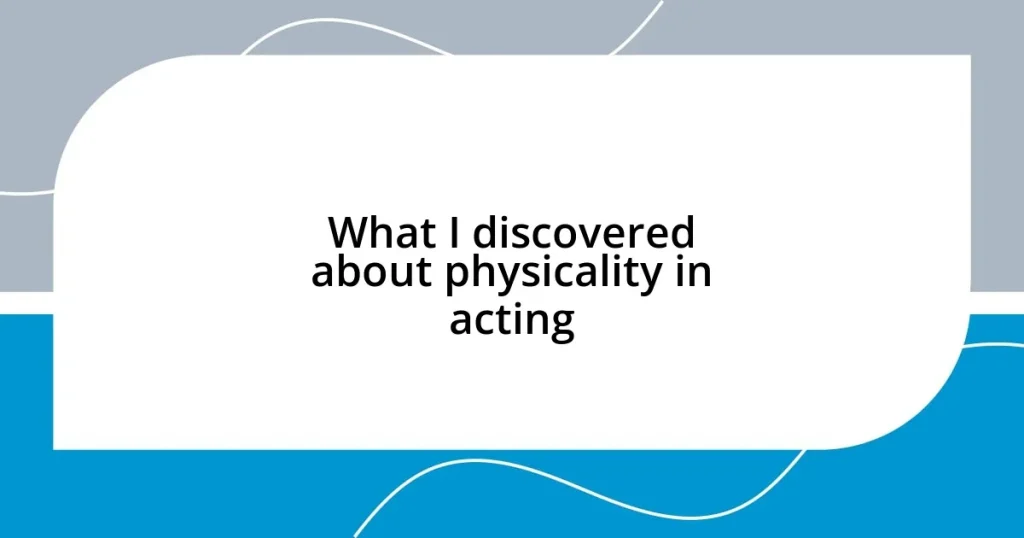Key takeaways:
- Physicality in acting expresses emotion and character, making non-verbal communication essential for connecting with the audience.
- Body language, including posture and gesture, significantly impacts how emotions are conveyed and perceived in performances.
- Techniques like mirror exercises and character physicality exploration enhance actors’ awareness and ability to embody their roles authentically.
- Integrating movement with emotion deepens character portrayal, allowing for a more relatable and engaging performance.
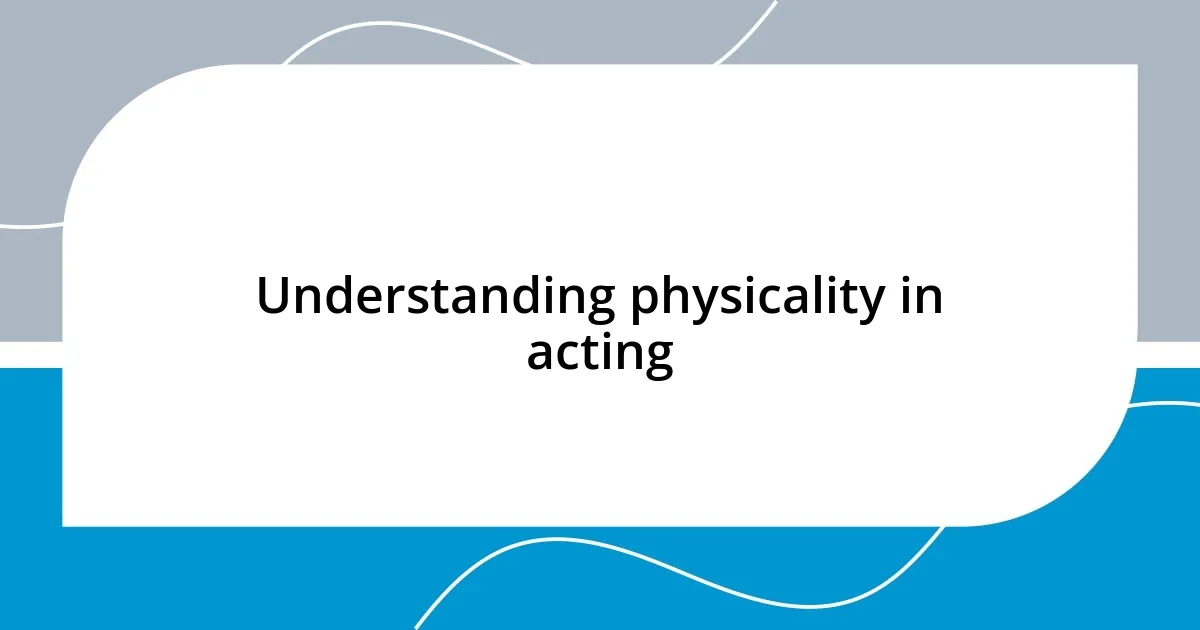
Understanding physicality in acting
Physicality in acting is more than just movement; it’s the expression of emotion and character through the body. I remember my first time on stage, where I discovered that the way I stood could convey tension or ease. Have you ever noticed how a slight shift in posture can change the entire energy of a scene? It’s fascinating how our physical choices can communicate so much without uttering a word.
As I delved deeper into this craft, I began to explore my own physicality and how it influenced my performance. For instance, embodying a character with stooped shoulders allowed me to convey vulnerability and self-doubt instantly. Isn’t it amazing how just adjusting your physical presence can transform your role while connecting you with the audience? The audience picks up on these nuances, and that connection can be incredibly powerful, reinforcing the idea that what we do physically matters just as much as the dialogue we deliver.
Moreover, understanding physicality means recognizing our body’s limitations and strengths. I recall a rehearsal where I played a character with a disability; it was both challenging and enlightening. I had to learn to navigate the space differently, which made me appreciate the nuances of movement in a whole new way. How does physicality shape your understanding of a character’s journey? Embracing these challenges fostered a richer performance and reminded me that every bodily movement tells a story, one thread woven into the larger tapestry of the narrative.

Importance of body language
Body language serves as a pivotal element in acting, as it often communicates what words cannot. I’ll never forget a scene where my character was overwhelmed with grief. It was the way I slumped my shoulders and turned my gaze downwards that truly conveyed that heavy emotional weight. Have you ever seen a performance where the actor’s hands trembled just a bit? It’s a small detail, but it can speak volumes about the character’s inner turmoil.
When I work with fellow actors on their body language, I encourage them to consider how their movements relate to their emotions. In one rehearsal, I witnessed a teammate channeling her character’s joy by skipping across the stage. That simple adjustment transformed the performance—it was as if the entire room lit up with her energy. Don’t you think it’s incredible how a little body language can shift the entire atmosphere of a scene?
As I learned more about physicality, I realized that even the tiniest gestures hold significance. A confident stride or a nervous fidget can signal to the audience exactly where a character stands emotionally. In one of my own performances, I played a character trying to hide anxiety with a casual posture, yet my fingers betrayed me as they fidgeted with the hem of my shirt. This unintentional move became a window for the audience to see the character’s struggle. How often do we underestimate the power of these subtle cues?
| Body Language Element | Impact on Performance |
|---|---|
| Posture | Conveys emotional state |
| Gestures | Shifts audience engagement |
| Facial Expressions | Reveals internal conflicts |
| Movement Pace | Sets emotional tone |

Key elements of physical expression
Physical expression in acting involves various components that intertwine seamlessly to create a relatable and believable performance. When I was preparing for a role characterized by deep-seated anger, an important realization dawned on me: the way I moved and occupied space had to assert that anger physically. The moment I stomped my feet while delivering heated lines, the audience felt that intensity rise. This blend of movement and emotion is essential.
Key elements of physical expression in acting include:
- Breath Control: Regulating breathing can enhance emotional authenticity—short, quick breaths can signify panic, while deep breaths can ground a character.
- Eye Contact: Establishing connections through gaze not only signifies interest but also creates tension or intimacy in a scene.
- Spatial Awareness: Understanding the physical space and how to navigate it can amplify or diminish a character’s presence.
- Physical Warm-ups: Engaging in exercises to loosen up can unlock greater freedom of movement and help portray emotions more vividly.
In another instance, while rehearsing for a comedic role, I discovered how physicality can enhance comedic timing. I began incorporating exaggerated movements—such as an over-the-top reaction to something simple—in my performance. Belting out a line with an unexpected slapstick gesture left the audience in stitches. It illustrated how the body can add a layer of humor that dialogue alone might not achieve. This blend of spontaneity and planning really solidified my understanding of physical expression as a vital storytelling tool.
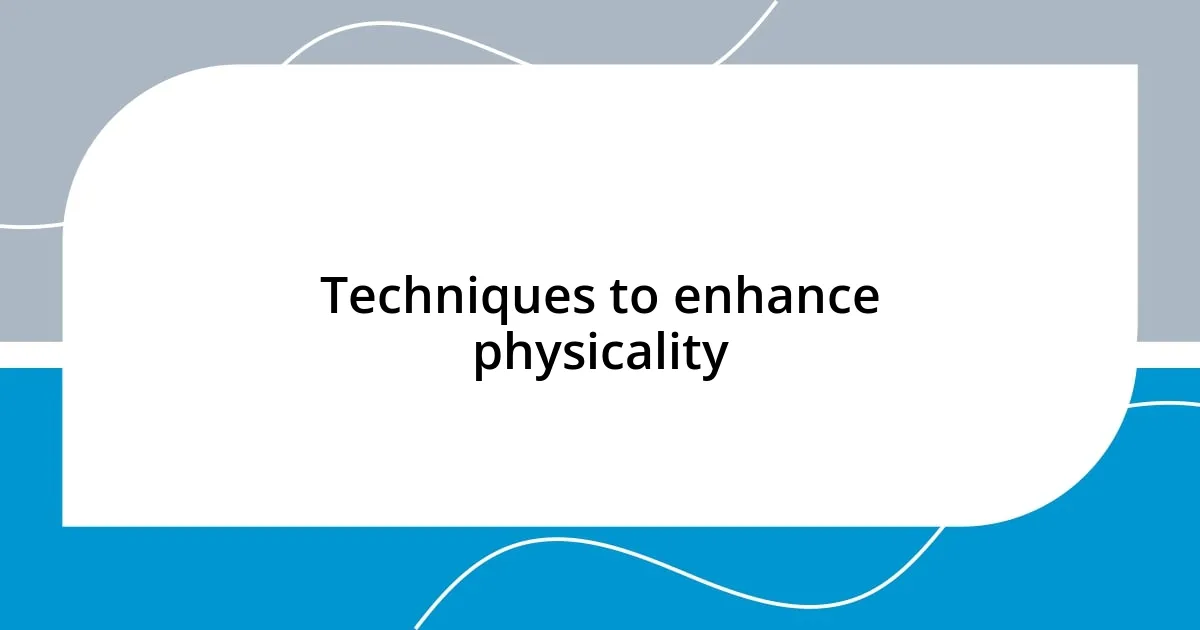
Techniques to enhance physicality
One technique I’ve found incredibly effective is the use of mirror exercises. In one of my acting classes, we paired up to observe and replicate each other’s movements and facial expressions. At first, it felt awkward, but as we continued, I discovered how deeply our physicality reveals our emotions. Have you ever noticed how even the most subtle shifts can change the entire feel of a scene? This practice not only enhances awareness of my own body but also sharpens my ability to respond to my scene partner’s physical cues, creating a more authentic dynamic.
Another approach is character physicality exploration. Before a performance, I often take time to walk around, embodying my character’s traits—how would they stand, move, or react? There was a time I played a character who was always on edge; I started bouncing on my toes, and the nervous energy seeped into every line I delivered. This physical embodiment helped ground me in the role, making the character more believable. Have you ever tried stepping into a character’s shoes—literally or figuratively? I found that once I embraced their physicality, the lines became more instinctual.
Incorporating improvisational movement games can open up new avenues of expression as well. I remember a workshop where we played a game where every word spoken had to be accompanied by a specific gesture. This playful approach not only loosened us up but sparked creativity. I could suddenly see how playful energy transitions into powerful moments. How often do we limit ourselves to what’s in the script? By stepping outside those boundaries, the magic of physicality takes center stage, transforming the performance in unexpected ways.

Impact of physicality on character
Exploring physicality really changed the way I approached my characters. I remember preparing for a role where my character was perceived as aloof and intimidating. I noticed that adopting a rigid posture and limiting my gestures immediately shifted how I interacted with my fellow actors and how the audience perceived me. It’s fascinating how such subtle changes in physicality can redefine the emotional landscape of a character. Have you ever noticed how a character’s posture can communicate their inner world without a single word?
In another experience, while rehearsing a scene as a soft-spoken introvert, I learned that minimal movement can speak volumes. I found that by taking small steps and using gentle hand gestures, I could articulate vulnerability and insecurity. Interestingly, my body seemed to echo the character’s hesitance, and I could sense the audience leaning in, drawn into the nuance of my portrayal. Isn’t it incredible how the simplest shift in physicality can elicit a powerful response from viewers?
Lastly, I’ve played roles that required energetic and frenetic movement, and these experiences taught me about the liberating nature of physicality. During one performance, I took to bounding around the stage, my movements mirroring the character’s chaotic mindset. The adrenaline rush was palpable, and I could feel the energy radiating through the audience. I often reflect on how my physical choices directly influenced both my emotional state and the audience’s engagement. Have you ever embraced a character’s energy so fully that it transformed your own experience on stage? It truly illustrates the profound impact that physicality has on shaping character and storytelling.
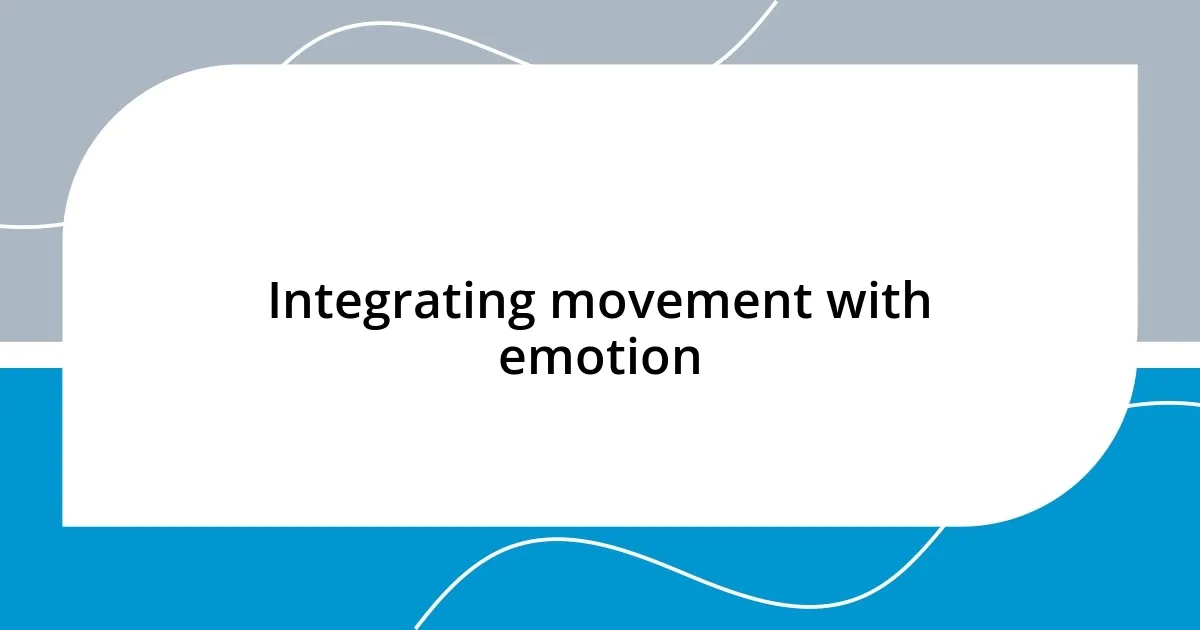
Integrating movement with emotion
Integrating movement with emotion is a dance that I’ve found essential in acting. I recall a rehearsal where my director encouraged us to physically express the emotions of our characters without using dialogue. I chose a scene filled with grief and, as I let my body collapse and my shoulders droop, I could feel that heaviness resonate within me. Have you ever experienced how embodying an emotion can shift your mindset? It’s almost as if movement unlocks a deeper layer of feeling that words alone cannot convey.
Another memory springs to mind from a workshop centered on dynamic movement. We were instructed to exaggerate our physical responses to emotional stimuli. At first, it seemed silly—running dramatically in circles to express joy or dragging our feet as if weighted down by despair. Yet, what surprised me was how these movements stirred something real inside me. I found joy bubbling up from my core as I leaped through the space, and in contrast, sadness was palpable as I crept across the floor. Isn’t it remarkable how letting our bodies lead can unearth genuine feeling?
Finally, I often find that collaborative movement with my scene partners enhances emotional depth. During one memorable performance, my co-actor and I instinctively mirrored each other’s nervous fidgeting, creating a shared energy that electrified the scene. It was as if our bodies spoke a language that transcended words, weaving together our characters’ fears and desires. How often do we overlook the silent connection that occurs through physicality? Engaging in such shared movement allows not just for better communication, but a richer emotional tapestry that envelops the audience.
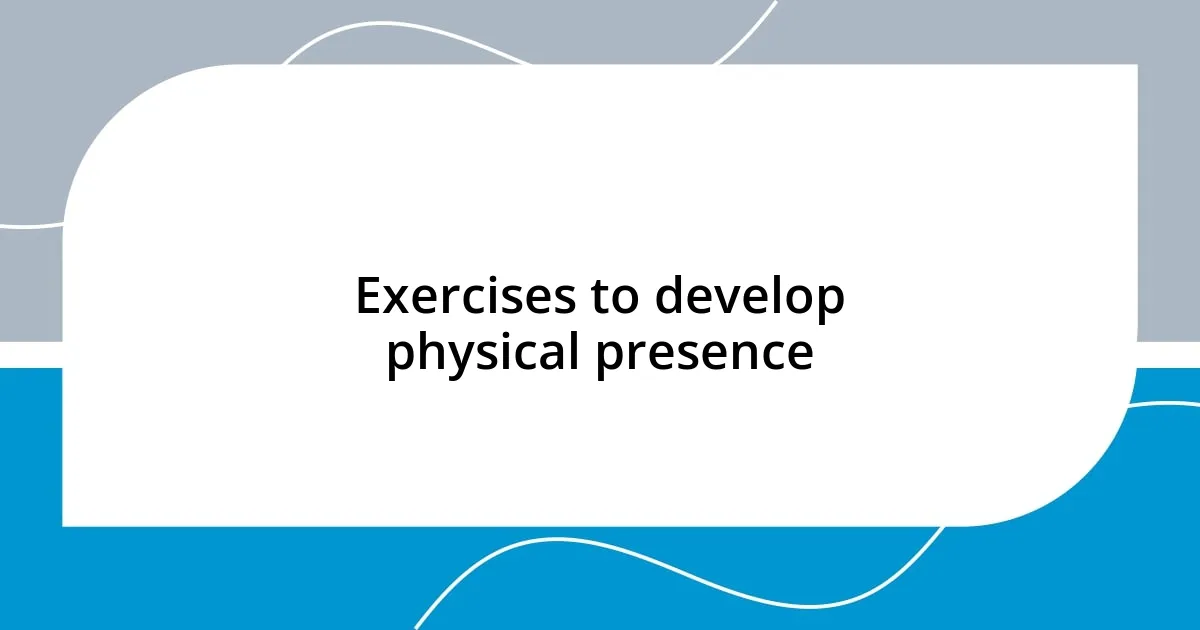
Exercises to develop physical presence
To truly develop a strong physical presence, I’ve found that engaging in movement-based exercises can make a world of difference. One exercise I particularly enjoy involves simply standing in front of a mirror and experimenting with different postures and gestures. I often try maintaining an open stance with arms wide to see how it changes my mindset. It’s fascinating to realize how embodying confidence physically not only makes me feel empowered but can also shift the energy in the room. Have you ever stood tall and noticed how your presence immediately commands attention?
Another technique I advocate is improvisational movement. I remember a session where we were encouraged to respond to music without overthinking it. As I let my body be spontaneous, I felt a surge of freedom. Each rhythm seemed to pull something different from me, allowing my personality to shine through. I discovered that moving freely not only opens up my physicality but also enhances my ability to connect emotionally with the character. Isn’t it liberating to discover how your body can express what words sometimes cannot?
Finally, I’ve found that grounding exercises are incredibly effective for cultivating physical presence. Once, I participated in a workshop where we focused on feeling the connection between our feet and the ground. As I stood there, consciously rooting myself, I could sense an immediate shift in my energy. It’s as if the earth’s stability flowed through me, and I felt centered and present. I’ve learned that when I ground myself in my physical space, it allows for a clearer connection to my character’s emotional landscape. Have you experienced the power of being truly present in your body? It’s a game-changer in the world of acting.











